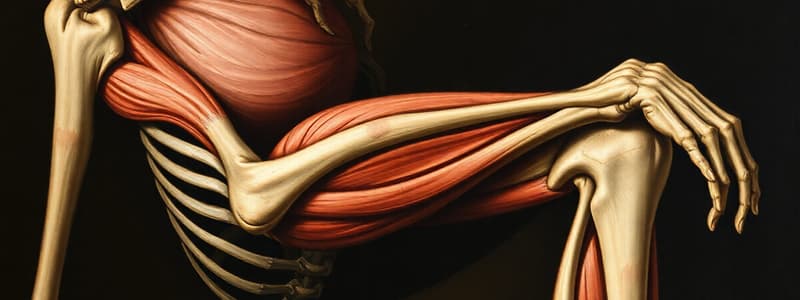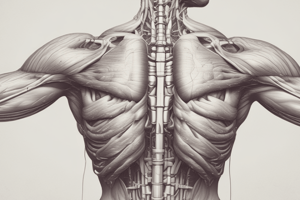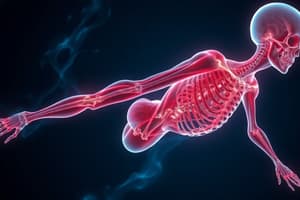Podcast
Questions and Answers
What is one of the primary functions of skeletal muscle?
What is one of the primary functions of skeletal muscle?
- Regulate blood pressure
- Generate heat (correct)
- Store excess lipids
- Facilitate hormonal secretion
Which component is found at the neuromuscular junction?
Which component is found at the neuromuscular junction?
- Tendon fibers
- Synaptic cleft (correct)
- Sarcomeres
- Myofibrils
What type of muscle tissue is involved in involuntary control and is responsible for pumping blood?
What type of muscle tissue is involved in involuntary control and is responsible for pumping blood?
- Smooth muscle
- Skeletal muscle
- Cardiac muscle (correct)
- Striated muscle
What is the role of the H band in the sarcomere structure?
What is the role of the H band in the sarcomere structure?
Which connective tissue surrounds individual muscle fibers?
Which connective tissue surrounds individual muscle fibers?
Which of the following describes the process of muscle contraction?
Which of the following describes the process of muscle contraction?
What type of muscle fibers are primarily responsible for voluntary movements?
What type of muscle fibers are primarily responsible for voluntary movements?
Which part of the sarcomere marks the boundary between adjacent sarcomeres?
Which part of the sarcomere marks the boundary between adjacent sarcomeres?
What triggers the release of acetylcholine (ACh) from the axon terminal?
What triggers the release of acetylcholine (ACh) from the axon terminal?
What occurs when an action potential reaches the axon terminal?
What occurs when an action potential reaches the axon terminal?
How does ACh affect the muscle action potential?
How does ACh affect the muscle action potential?
What is the role of the synaptic cleft in neurotransmission?
What is the role of the synaptic cleft in neurotransmission?
How is acetylcholine removed from the synaptic cleft?
How is acetylcholine removed from the synaptic cleft?
What defines an action potential in a neuron?
What defines an action potential in a neuron?
What happens to the axon's permeability when ACh binds to receptors on the motor end plate?
What happens to the axon's permeability when ACh binds to receptors on the motor end plate?
Which ions are primarily responsible for the generation of an action potential in muscles?
Which ions are primarily responsible for the generation of an action potential in muscles?
What is the primary role of acetylcholinesterase (AChE) in the motor end plate?
What is the primary role of acetylcholinesterase (AChE) in the motor end plate?
Which characteristic distinguishes cardiac muscle tissue from other muscle types?
Which characteristic distinguishes cardiac muscle tissue from other muscle types?
What is the function of intercalated disks in cardiac muscle?
What is the function of intercalated disks in cardiac muscle?
How are smooth muscle contractions primarily controlled?
How are smooth muscle contractions primarily controlled?
Which feature is associated with the spontaneous activity of cardiac muscle cells?
Which feature is associated with the spontaneous activity of cardiac muscle cells?
Which of the following correctly describes smooth muscle tissue?
Which of the following correctly describes smooth muscle tissue?
Which factor affects the rate of heart contractions in cardiac muscle?
Which factor affects the rate of heart contractions in cardiac muscle?
What is a primary distinguishing feature of skeletal muscle compared to cardiac muscle?
What is a primary distinguishing feature of skeletal muscle compared to cardiac muscle?
Flashcards are hidden until you start studying
Study Notes
Muscle Tissue Types
- Muscle is one of the four primary tissue types.
- There are three types of muscle tissue: skeletal, smooth, and cardiac.
- Each type plays a vital role in the body, such as movement, circulation, and organ function.
Functions of Skeletal Muscle
- Skeletal muscle is responsible for producing movement of the skeleton.
- It helps maintain body posture and position.
- Skeletal muscle supports soft tissues.
- It guards body entrances and exits.
- Skeletal muscle helps regulate body temperature.
- It can act as a nutrient store.
Skeletal Muscle Structure
- Skeletal muscle tissue is composed of muscle fibers, connective tissue, blood vessels, and nerves.
- Connective tissue surrounds and supports muscle fibers, including the epimysium (outermost), perimysium (surrounding bundles), and endomysium (around individual fibers).
Skeletal Muscle Fibers
- Each skeletal muscle fiber is composed of myofibrils, which are bundles of protein filaments.
- Myofibrils contain two types of protein filaments: thin filaments (actin) and thick filaments (myosin).
- Myofibrils are divided into segments called sarcomeres, which are the functional units of muscle contraction.
Sarcomere Structure
- A band: Contains both thick and thin filaments, including the M line (center of the band) and H band (thick filaments only).
- I band: Only contains thin filaments.
- Z line: Marks the boundary between adjacent sarcomeres.
Sliding Filament Model
- Muscle contraction is achieved through the sliding of thin and thick filaments over each other.
- This sliding causes the sarcomere to shorten and the muscle to contract.
Muscle Action
- Muscle contraction is an active process that involves muscle shortening.
- Muscle lengthening occurs passively due to external forces.
- Muscles can only pull, not push.
Neuromuscular Junction
- This is the point where nerve signals are transmitted to muscle fibers.
- The process involves the release of a neurotransmitter, acetylcholine (ACh), from the axon terminal of a motor neuron.
- ACh diffuses across the synaptic cleft and binds to receptors on the muscle fiber.
- This binding triggers an influx of sodium ions, generating an action potential that travels along the sarcolemma (muscle fiber membrane).
- The action potential ultimately leads to muscle contraction.
Cardiac Muscle Tissue
- Cardiac muscle is found only in the heart.
- It is excitable tissue, meaning it can generate electrical signals.
- Cardiac muscle cells are short and small, with a striated appearance.
- Cells are connected via intercalated disks, which allow for electrical continuity.
- Cardiac muscle relies heavily on aerobic metabolism for energy production.
Cardiac Muscle Activity
- Intercalated disks allow the heart to function as a single, coordinated unit.
- Cardiac muscle cells are spontaneously active, generating their own electrical impulses.
- The heart has both faster (pacemakers) and slower cells (triggered), setting the rhythm of contraction.
- The nervous system can modulate the heart rate and force of contraction.
Smooth Muscle Tissue
- Smooth muscle differs from skeletal and cardiac muscle.
- It plays a regulatory role in the body, found in organs like blood vessels, the integumentary system, and digestive tract.
- Smooth muscle does not have striations, and its cells are smaller and elongated.
- Contractions are often spontaneous and controlled primarily by hormones rather than nerve signals.
- Smooth muscle has a ‘bunching-up’ effect as it contracts.
Comparing Muscle Tissue
- skeletal muscle: Attached to bones, voluntary movement, striated
- cardiac muscle: Found only in the heart, involuntary movement, striated, connected by intercalated disks
- smooth muscle: Found in walls of organs, involuntary movement, not striated, cells are spindle-shaped
Studying That Suits You
Use AI to generate personalized quizzes and flashcards to suit your learning preferences.



